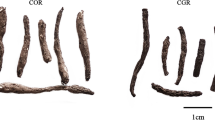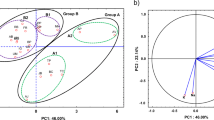Abstract
A method based on elemental analyser-isotope ratio mass spectrometer (EA-IRMS) was developed for the identification of the geographical origins of Schisandra fruits which are used as traditional Chinese medicines and important food materials. A total of 96 authentic samples from seven provinces in China were collected and subjected to stable carbon isotope ratio analysis (SCIRA), and the results showed that there were significant differences between the mean δ13C values of samples from different origins. By using single analyte δ13C, the Schisandra fruits from northeast China and south China could potentially be discriminated. A follow-up study will combine trace elements with stable isotope ratios to analyse a larger set of samples, to confirm the discrimination capability of 13C and to enhance the discrimination between close geographical regions.



Similar content being viewed by others
Abbreviations
- SCIRA:
-
Stable carbon isotope ratio analysis
- EA-IRMS:
-
Elemental analyser-isotope ratio mass spectrometry
- HPLC:
-
High-performance liquid chromatography
- IR:
-
Infrared spectra
- SSR-PCR:
-
Simple sequence repeat-polymerase chain reaction
- HLJ:
-
Heilongjiang Province
- JL:
-
Jilin Province
- LN:
-
Liaoning Province
- SX:
-
Shaanxi Province
- HB:
-
Hubei Province
- HN:
-
Hunan Province
- GX:
-
Guangxi Province
- CF-IRMS:
-
Continuous flow isotope ratio mass spectrometry
References
Xiao WL, Li RT, Huang SX, Pu JX, Sun HD (2008) Nat Prod Rep 25:871–891
Pharmacopoeia Commission of PRC (2005) Pharmacopoeia of the People’s Republic of China, vol 1. Chemical Industry Press, Beijing
Yan BQ, Wang J, Chen GP, Wang T (2009) Conserv Genet 10:615–617
Kuo YH, Kuo LMY, Chen CF (1997) J Org Chem 62:3242–3245
Qu HG (2005) Food Sci 26:112–115
Huang BX, Wang DW, Wang JF, Zhang W (2009) Liquor Making 36:77–78
Cai J (2005) Beverage Ind 8:17–18
Nie JL, Fu YJ, Wang ZY, Zhu YG, Li J (2002) Bull Bot Res 22:121–124
Zhou GP, Chen P, Zhou RR, Cheng ZD (2007) China Brewing 170:78–80
Wang S, Zhang JG (2003) Econ Forest Res 21:126–127
Guan XR, Huo F, Yu WD, Hu YH (2007) China Food Addit 4:110–113
Opletal L, Sovová H, Bártlová M (2004) J Chromatogr B 812:357–371
Zhu M, Cao Y, Fan GR (2007) J Liq Chromatogr Relat Technol 30:123–133
Tian JG, He XL (1995) J Chinese Med Mater 18:284–285
Sun Y, Li JP, Jin YC, Jiao HT (2003) Acta Chinese Med and Pharmacol 31:29–30
Sun Y, Liu YF, Huang HW (2009) Conserv Genet Resour 1:119–121
Kelly S, Heaton K, Hoogewern J (2005) Trends Food Sci Technol 16:555–567
Yeh HW, Wang WM (2001) Proc Natl Sci Counc Repub China B 25:137–147
Carelli MLC, Queiroz-Voltan RB, Fahl JI, Trivelin PCO (2003) Braz J of Plant Physiol (Brasil) 15:19–24
Feng HY, An LZ, Chen T, Qiang WY, Xu SJ, Zhang MX, Wang XL, Cheng GD (2003) Environ Exp Bot 49:1–8
Yoneyama T, Fujiwara H, Engelaar WMHG (2000) J Exp Bot 51:559–566
Branch S, Burke S, Evans P, Fairman B, Briche CSJW (2003) J Anal At Spectrom 18:17–22
Gao JP, Wang YH, Chen DF (2003) Acta Bot Boreal-Occident Sin 23:715–723
Hultine KR, Marshall JD (2000) Oecologia 123:32–40
Brescia MA, Di Martino G, Guillou C, Reniero F, Sacco A, Serra F (2002) Rapid Commun Mass Spectrom 16:2286–2290
Körner C, Farquhar GD, Wong SC (1991) Oecologia 88:30–40
Dong XC, Wang YH, Li GC, Li B, Wang SC (2010) Chinese J Ecol 29:2353–2357
Morecroft MD, Woodward FI (1990) J Exp Bot 41:1303–1308
Gremaud G, Quaile S, Piantini U, Pfammatter E, Corvi C (2004) Eur Food Res Technol 219:97–104
Acknowledgments
This article was supported by the international collaboration project foundation for agro-products safety of Shenyang, China (NO. 1091239-6-00). The authors would like to thank all the workers for sampling, and Professor Zhou Li-kai, professor Walter Steurbaut, and Tineke De Wilde for critical reading of the manuscript. The authors declare that they have no conflict of interest.
Author information
Authors and Affiliations
Corresponding author
Rights and permissions
About this article
Cite this article
Li, Gc., Wu, Zj., Wang, Yh. et al. Identification of geographical origins of Schisandra fruits in China based on stable carbon isotope ratio analysis. Eur Food Res Technol 232, 797–802 (2011). https://doi.org/10.1007/s00217-011-1445-5
Received:
Revised:
Accepted:
Published:
Issue Date:
DOI: https://doi.org/10.1007/s00217-011-1445-5




